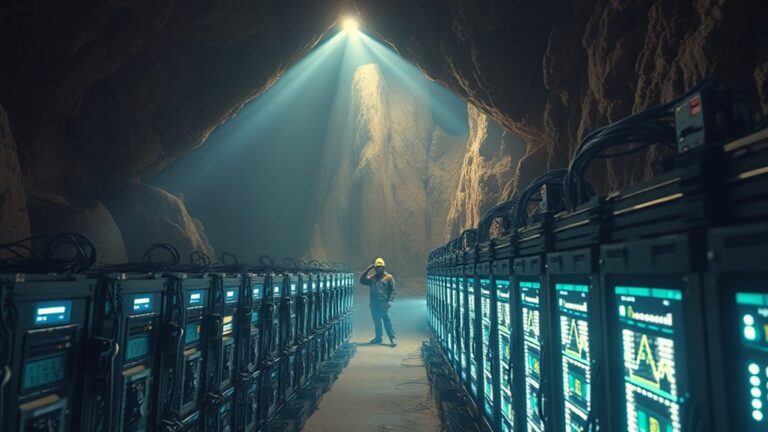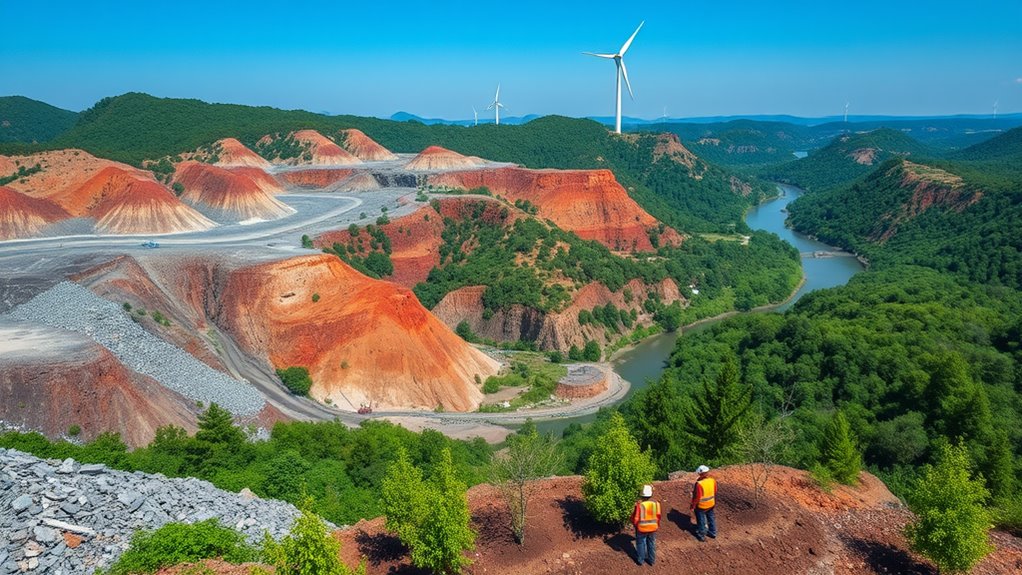
Mining’s Environmental Impact and Solutions: What Can Be Done?
Mining profoundly affects the environment in various ways, including carbon emissions, deforestation, and water pollution. Substantial carbon emissions arise primarily from crypto mining, contributing to climate change. Mining operations also lead to habitat destruction and water contamination, which adversely impacts aquatic life. To mitigate these effects, sustainable practices are essential. These include implementing renewable energy sources and adopting energy-efficient technologies. Continued exploration of solutions can offer further insights into responsible mining practices and community engagement strategies.
Key Takeaways
- Implement renewable energy sources, like solar and wind, in mining operations to significantly reduce carbon emissions and reliance on fossil fuels.
- Adopt energy-efficient algorithms to decrease overall energy consumption in crypto mining activities, minimizing their environmental footprint.
- Enforce government policies that incentivize sustainable practices and accountability within the mining industry, ensuring compliance with environmental impact assessments.
- Promote collaboration through initiatives like the Crypto Climate Accord for achieving carbon neutrality in mining by 2040.
- Prioritize the protection of Indigenous communities’ rights by ensuring informed consent and safeguarding cultural heritage during mining operations.
Understanding the Environmental Impact of Crypto Mining
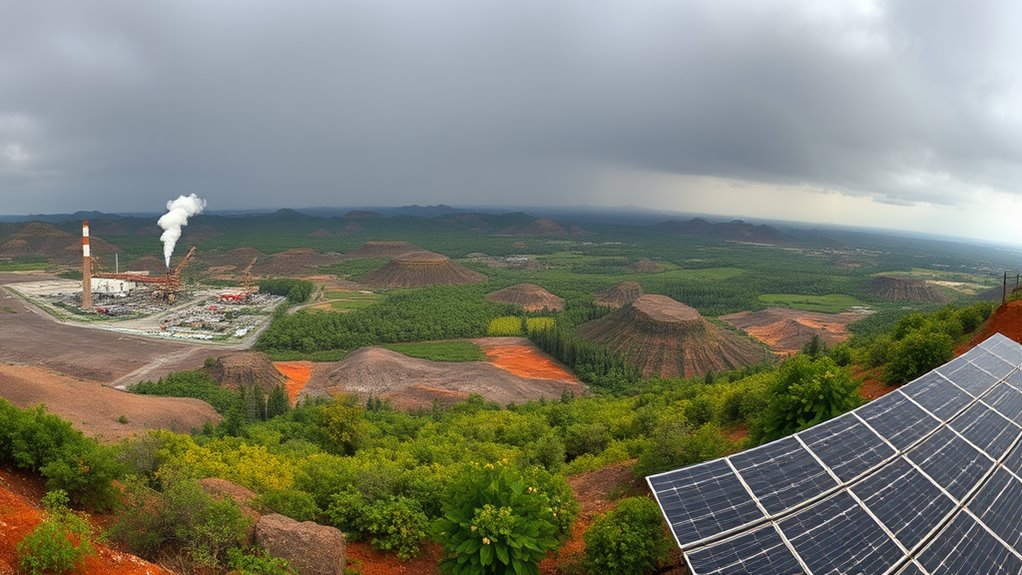
As the popularity of cryptocurrencies continues to rise, understanding the environmental impact of crypto mining becomes increasingly significant.
Crypto mining is a massive energy consumer, comparable to the electricity use of entire countries. For instance, Bitcoin mining alone emits about 86 megatons of carbon annually, primarily due to its reliance on fossil fuels. Approximately 46% of these emissions originate from the United States, with significant contributions also from China and Kazakhstan.
Bitcoin mining’s carbon emissions reach 86 megatons annually, heavily impacting the environment through fossil fuel reliance.
Additionally, Bitcoin mining consumes vast amounts of water, utilizing around 1.65 million liters globally in just one year. The industry’s growing demand only amplifies its environmental footprint, raising concerns about air pollution and health risks in communities near mining operations. Addressing these impacts is essential for sustainable development. Moreover, the push towards renewable energy sources is becoming crucial for reducing costs and enhancing sustainability in the mining sector.
Deforestation and Habitat Loss From Mining Operations

Mining operations profoundly impact biodiversity and can lead to ecosystem fragmentation, which disrupts natural habitats.
As forests are cleared for mining activities, many species face threats to their survival, while the remaining habitats become increasingly isolated.
Additionally, the displacement of Indigenous communities further complicates these environmental challenges, as these groups often rely on the land for their livelihoods and cultural practices.
Impact on Biodiversity
The detrimental impact of mining operations on biodiversity is evident through the extensive deforestation and habitat loss that frequently accompany these activities. Mining leads to significant biodiversity loss by destroying essential ecosystems, particularly in biodiversity hotspots. This habitat destruction is compounded by infrastructure development and the pollution of air and water resources.
| Impact Type | Consequences | Examples |
|---|---|---|
| Direct Habitat Loss | Vegetation removal | Forests to mines |
| Water Pollution | Altered aquatic ecosystems | Toxic runoff |
| Landscape Alteration | Long-term ecosystem changes | Changed hydrology |
These factors contribute to a fundamental disruption of local flora and fauna, ultimately threatening the delicate balance of natural ecosystems worldwide.
Ecosystem Fragmentation Effects
Ecosystem fragmentation, often resulting from deforestation and habitat loss due to mining operations, poses significant threats to biodiversity and ecosystem health.
Mining activities, particularly in tropical regions, contribute to habitat destruction and reduce biodiversity by up to 75%. This fragmentation creates smaller, isolated habitats that struggle to support diverse plant and animal species, leading to chronic ecosystem dysfunction.
Additionally, infrastructure development, such as roads and railways, further exacerbates habitat fragmentation, disrupting species migration and reducing population sizes. The alteration of edge-to-interior ratios in fragmented habitats affects species distributions and diminishes ecological services.
These cumulative effects underscore the urgent need for effective strategies to minimize habitat loss and protect remaining ecosystems from the long-term consequences of mining practices.
Indigenous Community Displacement
Indigenous communities face significant challenges as deforestation and habitat loss from mining operations disrupt their traditional ways of life.
Mining activities often force communities from their ancestral lands, leading to the destruction of cultural heritage sites and pushing individuals towards urban areas for better living conditions.
Many mining projects initiate without obtaining proper free, prior, and informed consent from these communities, violating their rights.
The environmental impacts are profound, as mining contributes to significant deforestation, biodiversity loss, and water pollution.
Additionally, increased militarization in mining regions can result in violence against Indigenous activists, further threatening their cultural practices and social structures.
The lack of recognition of land and resource rights exacerbates these issues, leaving many communities vulnerable to exploitation.
Water Pollution and Its Effects on Aquatic Life
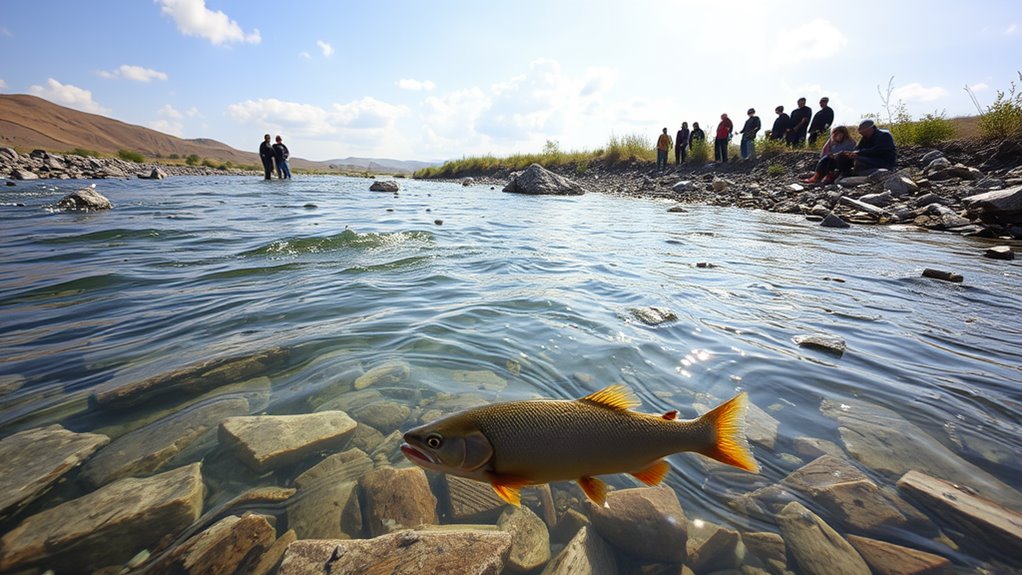
Water pollution resulting from mining activities poses significant threats to aquatic life.
Acid mine drainage and the release of heavy metals can drastically alter water quality, leading to harmful conditions for fish and other organisms.
Additionally, these pollutants disrupt ecosystems, affecting food chains and biodiversity, which may have long-lasting impacts on both the environment and local communities.
Acid Mine Drainage Effects
Acid mine drainage (AMD) poses a significant threat to aquatic life, primarily due to the harmful effects of its acidity and metal content.
When sulfide minerals are exposed to oxygen and water during mining, they produce sulfuric acid, which can drastically lower the pH of nearby water bodies. This acidic runoff can dissolve toxic metals, severely impacting aquatic ecosystems.
Streams contaminated by AMD often experience reduced biodiversity, harming fish and other organisms. In extreme cases, entire areas can become lifeless, with effects lasting for decades or even centuries.
The ongoing nature of AMD necessitates long-term water management strategies to mitigate these harmful impacts on aquatic life, highlighting the urgent need for effective environmental protection measures.
Heavy Metals Pollution Impact
Heavy metals pollution represents a significant environmental concern, particularly regarding its impact on aquatic life. Heavy metals, such as lead, cadmium, and mercury, can bioaccumulate in aquatic organisms, leading to toxicity and harming ecosystems.
Different species exhibit varying vulnerability to these metals, which can result in decreased biodiversity. The presence of heavy metals also reduces water quality, altering habitats and affecting the survival of aquatic species. Chronic exposure to these pollutants can lead to long-term ecological changes and diminish the resilience of aquatic ecosystems.
Sources of heavy metals include mining operations, industrial waste, agricultural runoff, and improper waste disposal. Addressing these sources is crucial for protecting aquatic life and maintaining healthy water systems.
Ecosystem Disruption Consequences
Ecosystem disruption due to mining activities poses serious consequences for aquatic life, affecting both the health of water bodies and the organisms that inhabit them.
Water pollution from mining occurs through processes such as acid mine drainage and chemical spills, which introduce harmful substances into aquatic ecosystems. These pollutants can lead to oxygen depletion, habitat destruction, and increased toxicity, ultimately resulting in declines in biodiversity.
Sedimentation from mining further exacerbates these issues by smothering habitats and restricting light penetration, which is essential for photosynthetic organisms.
The long-term impacts of these disruptions can be profound, as altered water chemistry and reduced habitat quality compromise ecosystem resilience and the survival of sensitive species, highlighting the urgent need for effective pollution mitigation strategies.
Carbon Emissions and Climate Change Concerns

Although mining plays an important role in providing essential resources, it also greatly contributes to carbon emissions and climate change concerns. Mining activities account for approximately 4% to 7% of global greenhouse gas emissions, primarily due to both direct operations and indirect emissions.
Key aspects include:
- Scope 1 and 2 Emissions: These represent about 1% of global emissions from mining operations and electricity use.
- Scope 3 Emissions: Indirect emissions, such as those from coal combustion, often exceed 95% of a mining company’s carbon footprint.
- Mining Techniques: Open pit mines generally emit more CO₂ per ounce of gold than underground mines.
- Renewable Energy: Shifting to renewable energy sources can greatly reduce emissions in the mining sector.
Health Risks Associated With Crypto Mining
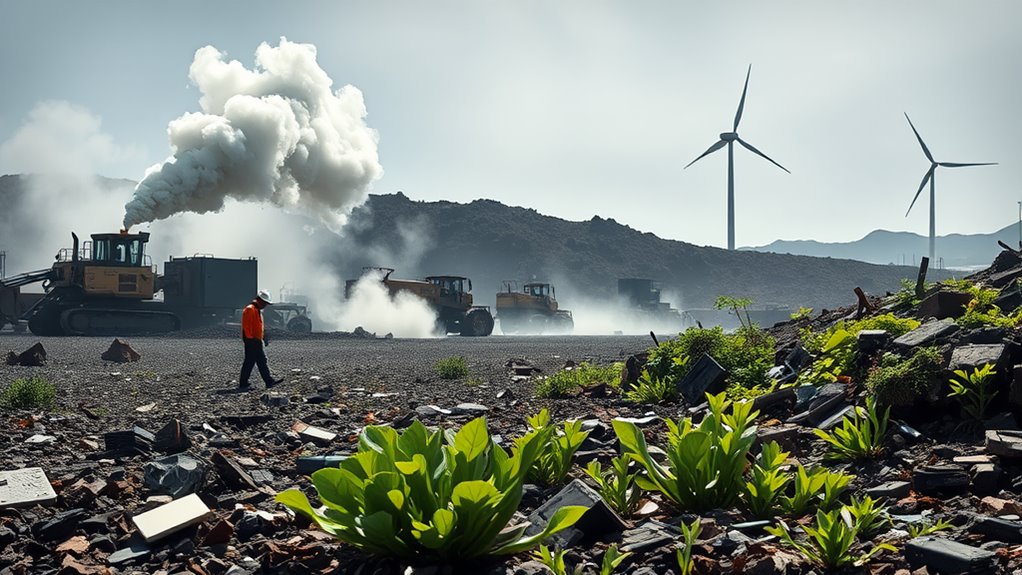
The health risks associated with crypto mining have garnered increasing attention due to their impact on local communities. Residents near crypto mining operations often experience noise pollution that exceeds World Health Organization limits, leading to sleep disturbances and heightened stress levels.
Reports of health issues, including migraines, hypertension, and vertigo, have prompted community complaints and legal action against mining companies. Chronic exposure to noise can result in significant short- and long-term health effects, including increased cardiovascular strain and potential neurological damage.
In addition, inadequate regulation complicates health assessments, making it essential for communities to monitor health impacts systematically. Overall, the intersection of noise pollution, air quality concerns, and community health underscores the urgent need for focused dialogue on these risks.
Sustainable Practices in Crypto Mining

As the demand for cryptocurrencies continues to rise, the adoption of sustainable practices in crypto mining has become increasingly vital. Various strategies are being implemented to reduce the environmental impact of mining activities.
Notable practices include:
- Renewable Energy Sources: Integration of solar, wind, and hydroelectric power is becoming common, markedly lowering carbon footprints.
- Energy-Efficient Algorithms: Shifting from Proof of Work (PoW) to Proof of Stake (PoS) reduces energy consumption drastically.
- Green Blockchain Initiatives: Collaborations like the Crypto Climate Accord aim for carbon neutrality in the crypto industry by 2040.
- Regulatory Support: Governments are introducing policies that incentivize miners to adopt renewable energy solutions, fostering a more sustainable mining environment.
Additionally, understanding the legal frameworks governing mining activities can aid in implementing responsible practices that align with environmental protection efforts.
These practices are essential for ensuring a balance between cryptocurrency growth and environmental responsibility.
The Role of Technology in Minimizing Environmental Damage
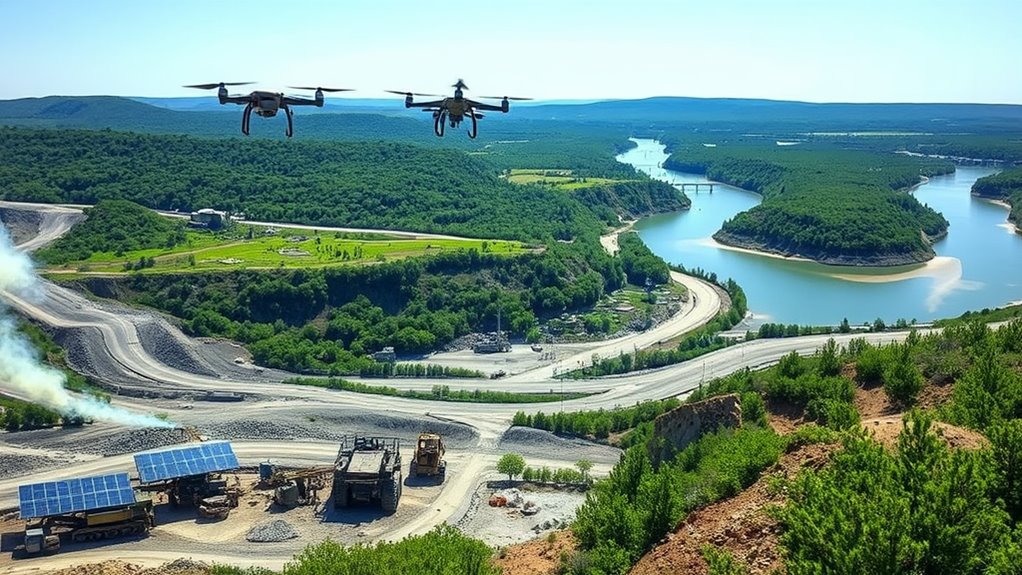
Technological advancements play a significant role in minimizing the environmental damage associated with mining activities.
Automation and digitization, such as autonomous vehicles and remote operating centers, enhance operational efficiency while reducing emissions. Electrification of equipment lessens air pollution, decreasing reliance on fossil fuels. Machine learning applications optimize processes, effectively minimizing waste.
Moreover, renewable energy integration, including solar and wind power, contributes to reduced carbon footprints. Innovations like wet earth fog cannons help control dust pollution, while bioliners prevent metal leaching from waste.
In addition, real-time monitoring systems enable immediate responses to environmental concerns. Collectively, these technologies foster a more sustainable approach to mining, balancing resource extraction with environmental stewardship.
Policy Initiatives for Responsible Mining Practices
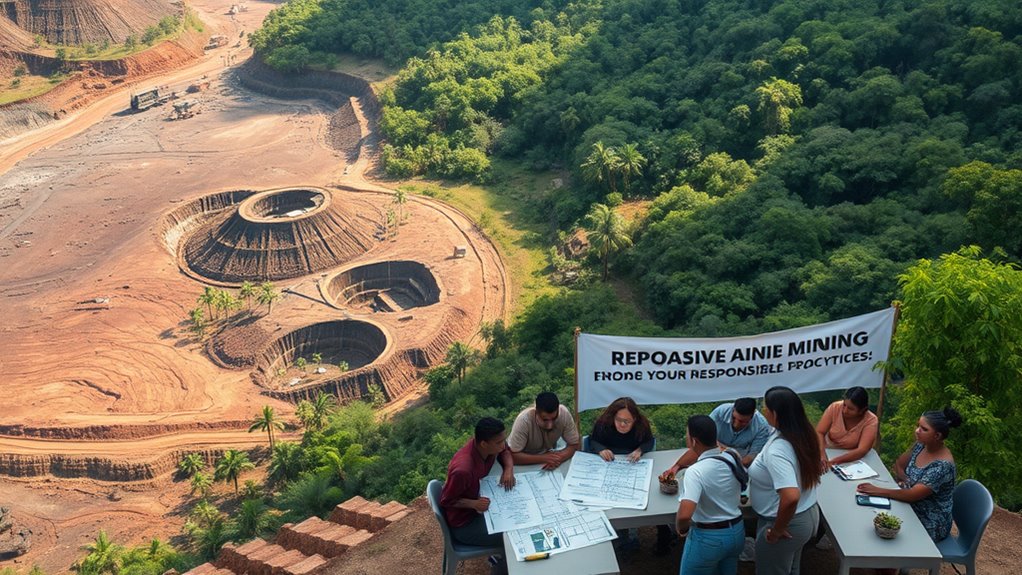
Recognizing the need for sustainable practices, various policy initiatives have emerged to promote responsible mining. These initiatives aim to enhance accountability and foster environmental care within the industry.
Key strategies include:
- Voluntary Initiatives: Programs like the Initiative for Responsible Mining Assurance (IRMA) provide third-party audits to guarantee transparency and accountability in mining operations.
- Performance-Based Regulations: Governments are shifting toward regulations that focus on performance outcomes rather than specific technologies.
- Environmental Impact Assessments: These assessments evaluate potential environmental effects before mining projects commence, helping to mitigate harm.
- Economic Instruments: Tools such as taxes and fees encourage mining companies to meet environmental targets, promoting responsible practices.
Together, these policies help shape a more sustainable mining landscape.
Community Engagement and Public Awareness Efforts

Community engagement and public awareness efforts are essential components of responsible mining practices that build upon the policy initiatives aimed at promoting sustainability. Engaging communities fosters trust, enhances a company’s reputation, and supports sustainable development by ensuring local input in decision-making. Effective strategies include thorough consultations, transparent dialogue, and respect for local cultures. However, challenges such as corruption, regulatory gaps, and external opposition can hinder meaningful engagement. The role of technology is crucial, as it can increase transparency and facilitate communication. Public awareness and education initiatives further empower communities to understand mining operations and their impacts.
| Benefit | Strategy | Challenge |
|---|---|---|
| Builds Trust | Thorough Consultations | Corruption Risks |
| Enhances Reputation | Transparent Dialogue | Regulatory Gaps |
| Supports Development | Involvement in Decision-Making | Opposition from Advocacy Groups |
| Encourages Participation | Personalized Communication | Balancing Interests |
| Mitigates Conflicts | Cultural Sensitivity | Long-Term Commitment |
Frequently Asked Questions
How Does Mining Affect Indigenous Communities’ Livelihoods?
Mining greatly disrupts Indigenous communities’ livelihoods by causing displacement, economic inequality, and cultural disturbance. Limited consultation and inadequate profit sharing further exacerbate these issues, hindering their traditional practices and access to essential services and infrastructure.
What Are the Long-Term Ecological Recovery Challenges After Mining?
Long-term ecological recovery after mining faces significant challenges, including severe habitat alteration, slow vegetation regrowth, and biodiversity loss. These factors complicate restoration efforts, emphasizing the need for effective strategies to support ecosystem rehabilitation and resilience.
How Does Mining Contribute to Soil Degradation?
Mining contributes to soil degradation by clearing vegetation, losing topsoil, introducing toxic chemicals, and disrupting natural water flows. These impacts lead to increased erosion, reduced biodiversity, and long-term contamination, severely affecting soil health and stability.
What Role Do Heavy Metals Play in Mining Pollution?
Heavy metals, including mercury and arsenic, are released during mining, contaminating ecosystems. Remarkably, one study found that over 80% of polluted waterways near mining sites contained elevated heavy metal concentrations, posing serious risks to health and biodiversity.
How Can Miners’ Mental Health Be Supported?
Miners’ mental health can be supported through extensive health plans, increased access to mental health resources, improved healthcare services in remote areas, and policies promoting work-life balance, ultimately enhancing their well-being and workplace productivity.
Conclusion
To summarize, the environmental impact of crypto mining is significant, affecting ecosystems and contributing to climate change. For instance, a mining operation in a forested area could lead to habitat destruction and increased carbon emissions, exacerbating local environmental issues. However, by adopting sustainable practices, utilizing advanced technology, and fostering community engagement, the industry can mitigate these harmful effects. Ultimately, a collective effort is essential to guarantee that crypto mining can coexist with environmental stewardship.




